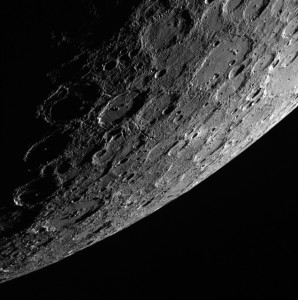Dark Mercury
April 2, 2015
Scientists at Brown University in Providence, Rhode Island, have proposed that the dark surface of Mercury, the closest planet to the sun in the solar system, formed from a steady “rain” of carbon-rich dust from passing comets, which has “painted” the surface of the planet for billions of years. The darkness of the planet’s surface has long puzzled planetary scientists.

Mercury’s dark surface, photographed from NASA’s Messenger probe. (Credit: NASA/Johns Hopkins University Applied Physics Laboratory/Carnegie Institution of Washington)
Mercury is dry, extremely hot, and almost airless. Like the moon, Mercury is covered by broad, flat plains; steep cliffs; and many deep craters similar to those on the moon. The craters formed when meteoroids or small comets crashed into the planet. However, unlike the moon, the surface of Mercury reflects only about 6 percent of the sunlight it receives.
Many asteroids and moons in the solar system get their dark color from iron-bearing minerals on their surface. But scientists know Mercury is covered by a thin layer of minerals called silicates that contain almost no iron. The Brown University scientists theorized that carbon-rich dust from passing comets could be the cause of Mercury’s dark color. The amount of comet dust in the solar system increases near Mercury as the icy bodies release great amounts of gas and dust approaching the sun.
Oddly, the scientists found that comets that struck Mercury would have no affect on the coloration of the planet’s surface. A direct hit by a comet would blast all of the surface impact material into space. The scientists calculated impact angles and speeds and found that a gentle rain of dark comet dust would accumulate on Mercury’s surface as the icy bodies passed in their journey around the sun.
The scientists are hoping that NASA’s Messenger probe can obtain information on the carbon content of Mercury’s surface next month as it continues to come closer to the planet. Launched in 2004, the Messenger flew by Mercury in 2009 and went into orbit around the planet in March 2011. The probe was designed to map Mercury’s surface and study its composition, interior structure, and magnetic field for one year. As of March 2015, Messenger was still sending information about Mercury back to Earth. Scientists expect the probe will crash into Mercury by May 2015.
Other World Book articles:


